Energy transition
Energy transition is a phrase that generally refers to significant structural change in an energy system


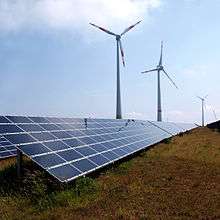
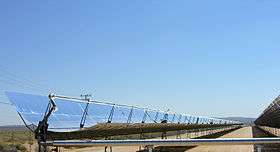
.[1] Historically, these changes have been driven by the demand for and availability of different fuels.[2] The current transition to renewable energy, and perhaps other types of sustainable energy, differs as it is largely driven by a recognition that global carbon emissions must be brought to zero, and since fossil fuels are the largest single source of carbon emissions, we must change energy systems worldwide to replace fossil fuels.
An example of transition toward sustainable energy, is the shift by Germany (German: Energiewende) and Switzerland,[3] to decentralised renewable energy, and energy efficiency. Although so far these shifts have been replacing nuclear energy, their declared goal 2012 was the abolishment of coal, reducing non-renewable energy sources[4] and the creation of an energy system based on 60% renewable energy by 2050.[5] As of 2018, the 2030 coalition goals are to achieve 65% renewables in electricity production until 2030 in Germany.[6]
Defining the term "energy transition"
An "energy transition" designates a significant change for an energy system that could be related to one or a combination of system structure, scale, economics, and energy policy. An 'energy transition' is usefully defined as a change in the state of an energy system as opposed to a change in an individual energy technology or fuel source.[7] A prime example is the change from a pre-industrial system relying on traditional biomass and other renewable power sources (wind, water, and muscle power) to an industrial system characterized by pervasive mechanization (steam power) and the use of coal. Market shares reaching pre-specified thresholds are typically used to characterize the speed of transition (e.g. coal versus traditional biomass) and typical market share thresholds in the literature are 1%, 10% for the initial shares and 50%, 90% and 99% for outcome shares following a transition.[8]
The term 'energy transition' could also encompasses a reorientation of policy and this is often the case in public debate about energy policy. For example, this could imply a rebalance of demand to supply and a shift from centralized to distributed generation (for example, producing heat and power in very small cogeneration units), which should replace overproduction and avoidable energy consumption with energy-saving measures and increased efficiency.[9] In a broader sense the energy transition could also entail a democratization of energy[10] or a move towards increased sustainability.
History

Historic energy transitions are most broadly described by Vaclav Smil.[2] Contemporary energy transitions differ in terms of motivation and objectives, drivers and governance. The layout of the world’s energy systems has changed significantly over time. Until the 1950s, the economic mechanism behind energy systems was local rather than global.[11] As development progressed, different national systems became more and more integrated becoming the large, international systems seen today. Historical transition rates of energy systems have been extensively studied.[12] While historical energy transitions were generally protracted affairs, unfolding over many decades, this does not necessarily hold true for the present energy transition, which is unfolding under very different policy and technological conditions.[13]
For current energy systems, many lessons can be learned from history.[14][15] The need for large amounts of firewood in early industrial processes in combination with prohibitive costs for overland transportation led to a scarcity of accessible (e.g. affordable) wood and it has been found that eighteenth century glass-works “operated like a forest clearing enterprise.[16] When Britain had to resort to coal after largely having run out of wood, the resulting fuel crisis triggered a chain of events that two centuries later culminated in the Industrial Revolution.[17][18] Similarly, increased use of peat and coal was vital elements paving the way for the Dutch Golden Age roughly spanning the entire 17th century.[19] Another example where resource depletion triggered technological innovation and a shift to new energy sources in 19th Century whaling and how whale oil eventually became replaced by kerosene and other petroleum-derived products.[20]
Reasons for a fast energy transition

Solving the global warming problem is regarded as the most important challenge facing humankind in the 21st century.[21] The capacity of the earth system to absorb greenhouse gas emissions is already exhausted, and under the Paris climate agreement, emissions must cease by 2040 or 2050.[22] Barring a breakthrough in carbon sequestration technologies, this requires an energy transition away from fossil fuels such as oil, natural gas, lignite, and coal. This energy transition is also known as the decarbonization of the energy system or "energy turnaround". Available technologies are nuclear power (fission) and the renewable energy sources wind, hydropower, solar power, geothermal, and marine energy.
A timely implementation of the energy transition requires multiple approaches in parallel. Energy conservation and improvements in energy efficiency thus play a major role. Smart electric meters can schedule energy consumption for times when electricity is abundant, reducing consumption at times when the more variable renewable energy sources are scarce (night time and lack of wind).
Technology has been identified as an important but difficult-to-predict driver of change within energy systems.[23] Published forecasts have systematically tended to overestimate the potential of new energy and conversion technologies and underestimated the inertia in energy systems and energy infrastructure (e.g. power plants, once built, characteristically operate for many decades). The history of large technical systems is very useful for enriching debates about energy infrastructures by detailing many of their long-term implications.[24] The speed at which a transition in the energy sector needs to take place will be historically rapid.[25] Moreover, the underlying technological, political, and economic structures will need to change radically — a process one author calls regime shift.[26]
Risks and barriers
Despite the widespread understanding that a transition to renewable energy is necessary, there are a number of risks and barriers to making renewable energy more appealing than conventional energy. Renewable energy rarely comes up as a solution beyond combating climate change, but has wider implications for food security and employment.[27] This further supports the recognized dearth of research for clean energy innovations, which may lead to quicker transitions.[28] Overall, the transition to renewable energy requires a shift among governments, business, and the public. Altering public bias may mitigate the risk of subsequent administrations de-transitioning - through perhaps public awareness campaigns or carbon levies.[29]
Labor
A large portion of the global workforce works directly or indirectly for the fossil fuel economy.[30] Moreover, many other industries that are dependent on unsustainable energy sources (such as the steel industry or cement and concrete industry). Transitioning these workforces during the rapid period of economic change requires considerable forethought and planning. The international labor movement has advocated for a just transition that addresses these concerns.
Just transition
Just Transition is a framework developed by the trade union movement[31] to encompass a range of social interventions needed to secure workers' rights and livelihoods when economies are shifting to sustainable production, primarily combating climate change and protecting biodiversity. The concept can be considered an ecological application of economic conversion, which was developed in the 1980s when anti-war activists sought to build a coalition with military workers and give them a stake in the peace economy.
Climate goals and global climate change agreements set standards for a clean economy. In the process, sectors such as energy, manufacturing, agriculture, and forestry, which employ millions of workers, must restructure. There is a concern that periods of economic structural change in the past have left ordinary workers, their families, and communities to bear the costs of the transition to new ways of producing wealth, leading to unemployment, poverty, and exclusion for the working class, in contrast to business owners who are able to afford the transition.[32] Just Transition addresses this concern by promoting sustainable actions that help workers. Uniting social and climate justice by means of a Just Transition means to comply with demands for fairness for coal workers in coal-dependent developing regions who lack employment opportunities beyond coal; fairness for workers in emerging economies that demand their share of the “industrialisation dividend”; fairness for those having to leave their homes as sea levels rise and engulf coastal regions and islands as a consequence of climate change; fairness for populations affected by the air pollution and broader environmental impacts of coal use etc. For example, the Green New Deal outlines goals to protect the climate, and a Just Transition framework outlines strategies to accomplish these goals while protecting workers.[33]
It has been endorsed internationally by governments in different arenas, including the International Labour Organization (ILO)'s 2015 "Guidelines on a Just Transition towards environmentally-sustainable economies and societies for all," the United Nations Framework Convention on Climate Change (UNFCCC)'s Paris Agreement, and the Katowice Climate Conference (COP24)'s 2018 Solidarity and Just Transition Silesia Declaration.[34][35][36]Predictions

After a transitional period, renewable energy production is expected to make up most of the world's energy production. The risk management firm, DNV GL, forecasts that, by 2050, the world's primary energy mix will be split equally between fossil and non-fossil sources.[37] A 2011 projection by the International Energy Agency expects solar PV to supply more than half of the world's electricity by 2060, dramatically reducing the emissions of greenhouse gases.[38]
The GeGaLo index of geopolitical gains and losses assesses how the geopolitical position of 156 countries may change if the world fully transitions to renewable energy resources. Former fossil fuels exporters are expected to lose power, while the positions of former fossil fuel importers and countries rich in renewable energy resources is expected to strengthen.[39]
Status in specific countries
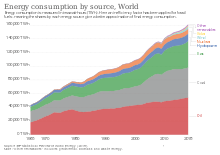
%2C_OWID.svg.png)
The the U.S. Energy Information Administration (EIA) estimates that, in 2013, total global primary energy supply (TPES) was 157.5 petawatt hours or 1.575×1017 Wh (157.5 thousand TWh; 5.67×1020 J; 13.54 billion toe) or about 18 TW-year.[40] From 2000–2012 coal was the source of energy with the total largest growth. The use of oil and natural gas also had considerable growth, followed by hydropower and renewable energy. Renewable energy grew at a rate faster than any other time in history during this period. The demand for nuclear energy decreased, in part due to nuclear disasters (Three Mile Island in 1979, Chernobyl in 1986, and Fukushima in 2011).[41][42] More recently, consumption of coal has declined relative to renewable energy. Coal dropped from about 29% of the global total primary energy consumption in 2015 to 27% in 2017, and non-hydro renewables were up to about 4% from 2%.[43]
Australia
Australia has one of the fastest deployment rates of renewable energy worldwide. The country has deployed 5.2 GW of solar and wind power in 2018 alone and at this rate, is on track to reach 50% renewable electricity in 2024 and 100% in 2032.[44] However, Australia may be one of the leading major economies in terms of renewable deployments, but it is one of the least prepared at a network level to make this transition, being ranked 28th out of the list of 32 advanced economies on the World Economic Forum’s 2019 Energy Transition Index.[45]
Austria
Austria embarked on its energy transition (Energiewende) some decades ago. Due to geographical conditions, energy production in Austria relies heavily on renewable energies, notably hydropower. 78.4% of domestic production in 2013 came from renewable energy, 9.2% from natural gas and 7.2% from petroleum. (rest: waste). On the basis of the Federal Constitutional Law for a Nuclear-Free Austria, no nuclear power stations are in operation in Austria. But domestic energy production makes up only 36% of Austria's total energy consumption, which among other things encompasses transport, electricity production, and heating. In 2013, oil accounts for about 36.2% of total energy consumption, renewable energies 29.8%, gas 20.6%, and coal 9.7%. In the past 20 years, the structure of gross domestic energy consumption has shifted from coal and oil to new renewables, in particular between 2005 and 2013 (plus 60%). The EU target for Austria require a renewables share of 34% by 2020 (gross final energy consumption). Austria is on a good way to achieve this target (32.5% in 2013). Energy transition in Austria can be also seen on the local level, in some villages, towns and regions. For example, the town of Güssing in the state of Burgenland is a pioneer in independent and sustainable energy production. Since 2005, Güssing has already produced significantly more heating (58 gigawatt hours) and electricity (14 GWh) from renewable resources than the city itself needs.[46]
Denmark
Denmark, as a country reliant on imported oil, was impacted particularly hard by the 1973 oil crisis. This roused public discussions on building nuclear power stations to diversify energy supply. A strong anti-nuclear movement developed, which fiercely criticized nuclear power plans taken up by the government,[47] and this ultimately led to a 1985 resolution not to build any nuclear power stations in Denmark.[48] The country instead opted for renewable energy, focusing primarily on wind power. Wind turbines for power generation already had a long history in Denmark, as far back as the late 1800s. As early as 1974 a panel of experts declared "that it should be possible to satisfy 10% of Danish electricity demand with wind power, without causing special technical problems for the public grid."[49] Denmark undertook the development of large wind power stations — though at first with little success (like with the Growian project in Germany).
Small facilities prevailed instead, often sold to private owners such as farms. Government policies promoted their construction; at the same time, positive geographical factors favored their spread, such as good wind power density and Denmark's decentralized patterns of settlement. A lack of administrative obstacles also played a role. Small and robust systems came on line, at first in the power range of only 50-60 kilowatts — using 1940s technology and sometimes hand-crafted by very small businesses. In the late seventies and the eighties a brisk export trade to the United States developed, where wind energy also experienced an early boom. In 1986 Denmark already had about 1200 wind power turbines,[50] though they still accounted for just barely 1% of Denmark's electricity.[51] This share increased significantly over time. In 2011, renewable energies covered 41% of electricity consumption, and wind power facilities alone accounted for 28%.[52] The government aims to increase wind energy's share of power generation to 50% by 2020, while at the same time reducing carbon dioxide emissions by 40%.[53] On 22 March 2012, the Danish Ministry of Climate, Energy and Building published a four-page paper titled "DK Energy Agreement," outlining long-term principles for Danish energy policy.[54]
The installation of oil and gas heating is banned in newly constructed buildings from the start of 2013; beginning in 2016 this will also apply to existing buildings. At the same time an assistance program for heater replacement was launched. Denmark's goal is to reduce the use of fossil fuels 33% by 2020. The country is scheduled to attain complete independence from petroleum and natural gas by 2050.[55]
France

Since 2012, political discussions have been developing in France about the energy transition and how the French economy might profit from it.[56]
In September 2012, Minister of the Environment Delphine Batho coined the term "ecological patriotism." The government began a work plan to consider starting the energy transition in France. This plan should address the following questions by June 2013:[57]
- How can France move towards energy efficiency and energy conservation? Reflections on altered lifestyles, changes in production, consumption, and transport.
- How to achieve the energy mix targeted for 2025? France's climate protection targets call for reducing greenhouse gas emissions 40% by 2030, and 60% by 2040.
- Which renewable energies should France rely on? How should the use of wind and solar energy can be promoted?
- What costs and funding models will likely be required for alternative energy consulting and investment support? And how about for research, renovation, and expansion of district heating, biomass, and geothermal energy? One solution could be a continuation of the CSPE, a tax that is charged on electricity bills.
The Environmental Conference on Sustainable Development on 14 and 15 September 2012 treated the issue of the environmental and energy transition as its main theme.[58]
On 8 July 2013, the national debate leaders submits some proposals to the government. Among them, there were environmental taxation, and smart grid development.[59]
In 2015, the National Assembly has adopted legislation for the transition to low emission vehicles.[60]
France is second only to Denmark as having the worlds lowest carbon emissions in relation to gross domestic product.[61]
Germany
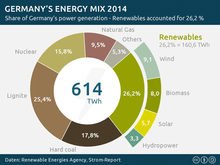
Germany has played an outsized role in the transition away from fossil fuels and nuclear power to renewables. The energy transition in Germany is known as die Energiewende (literally, "the energy turn" indicating a turn away from old fuels and technologies to new one. The key policy document outlining the Energiewende was published by the German government in September 2010, some six months before the Fukushima nuclear accident; legislative support was passed in September 2010.
The policy has been embraced by the German federal government and has resulted in a huge expansion of renewables, particularly wind power. Germanys share of renewables has increased from around 5% in 1999 to 17% in 2010, reaching close to the OECD average of 18% usage of renewables.[63] Producers have been guaranteed a fixed feed-in tariff for 20 years, guaranteeing a fixed income. Energy co-operatives have been created, and efforts were made to decentralize control and profits. The large energy companies have a disproportionately small share of the renewables market. Nuclear power stations were closed, and the existing nine stations will close earlier than necessary, in 2022.
The reduction of reliance on nuclear stations has had the consequence of increased reliance on fossil fuels. One factor that has inhibited efficient employment of new renewable energy has been the lack of an accompanying investment in power infrastructure to bring the power to market. It is believed 8300 km of power lines must be built or upgraded.[63]
Different Länder have varying attitudes to the construction of new power lines. Industry has had their rates frozen and so the increased costs of the Energiewende have been passed on to consumers, who have had rising electricity bills. Germans in 2013 had some of the highest electricity costs in Europe.[64] Nonetheless, for the first time in more than ten years, electricity prices for household customers fell at the beginning of 2015.[65]
Japan
On 14 September 2012 the Japanese government decided at a ministerial meeting in Tokyo to phase out nuclear power by the 2030s, or 2040 at the very latest. The government said that it would take "all possible measures" to achieve this goal.[66] A few days later the government retrenched the planned nuclear phaseout after the industry pushed for reconsideration. Arguments cited were that a nuclear phaseout would burden the economy and that imports of oil, coal, and gas would bring high added costs. The government then approved the energy transition, but left open the time-frame for decommissioning the nuclear power stations.[67]
South Korea
The basic ideology of the Korean energy transition can be found in the remarks by President Moon Jae-in at a ceremony marking the permanent closure of the Kori No.1 nuclear reactor (June 19, 2017). In his remarks, he mentioned that since "an understanding that the lives and safety of the people are more important than anything else has been firmly established as a social consensus, the national energy policy should also be in step with these changes" and that "an era of clean energy, in which public safety is the top priority, is the goal that our energy policy should pursue." [68]
The Ministry of Trade, Industry, and Energy (MOTIE) has claimed that an energy transition is necessary in order to comply with the public's demands for their lives, their safety, and the environment. In addition, the ministry has stated that the direction of the future energy policy is "to transition (from conventional energy sources) to safe and clean energy sources." Unlike in the past, the keynote of the policy is to put emphasis on safety and the environment rather than on stability of supply and demand and economic feasibility and is to shift its reliance on nuclear power and coal to clean energy sources like renewables.[69]
The energy transition in South Korea is a transition towards safe and clean energy with priority given to renewables. In 1981, the primary energy was sourced predominantly by oil and coal with oil accounting for 58.1% and coal 33.3%. As the shares of nuclear power and liquefied natural gas have increased over the years, the share of oil has decreased gradually. The primary energy broke down as follows in 1990: 54% oil, 26% coal, 14% nuclear power, 3% liquefied natural gas, and 3% renewables. Later on, with efforts to reduce greenhouse gas emissions in the country through international cooperation and to improve environmental and safety performances, it broke down as follows in 2017: 40% oil, 29% coal, 16% liquefied natural gas, 10% nuclear power, and 5% renewables. [70] Under the 8th Basic Plan for Long-term Electricity Supply and Demand, presented at the end of 2017, the shares of nuclear and coal are getting decreased while the share of renewables is expanding.
In June 2019, the Korean government confirmed the Third Energy Master Plan, also called as a constitutional law of the energy sector and renewed every five years. Its goal is to achieve sustainable growth and enhance the quality of life through energy transition. There are five major tasks to achieve this goal. First, with regards to consumption, the goal is to improve energy consumption efficiency by 38% compared to the level of 2017 and to reduce energy consumption by 18.6% below the BAU level by 2040. Second, with respect to generation, the task is to bring a transition towards a safe and clean energy mix by raising the share of renewable energy in power generation (30~35% by 2040) and by implementing a gradual phase-out of nuclear power and a drastic reduction of coal. Third, regarding the systems, the task is to raise the share of distributed generation nearby where demand is created with renewables and fuel cells and to enhance the roles and responsibility of local governments and residents. Fourth, with regards to the industry, the task is to foster businesses related to renewables, hydrogen, and energy efficiency as a future energy industry, to help the conventional energy industry develop higher value-added businesses, and to support the nuclear power industry to maintain its main ecosystem. The fifth task is to improve the energy market system of electricity, gas, and heat in order to promote energy transition and is to develop an energy big data platform in order to create new businesses. [71] [72]
| Title | Date | Contents |
|---|---|---|
| Energy Transition Road Map | October 2017 | · policy direction of a gradual nuclear phase-out
· cancellation of plans for new nuclear reactors, no extension of lifespan of old reactors |
| Renewable Energy 3020 Plan | December 2017 | · measures to improve renewables deployment
in order to raise its share in the power generation to 20% by 2030(7.6% as of 2017) |
| The 8th Basic Plan for Long-term
Electricity Supply and Demand |
December 2017 | · configuration measures for power facilities with
improved environmental and safety performances by 2030 |
| Energy Transition(Nuclear)
Complementary Measure |
May 2018 | · follow-up and complementary measures for the
neighboring areas (industry, human resources) in the process of a gradual phase-out |
| Solutions to Side Effects of Solar
and Wind Energy |
June 2018 | · solutions to side effects such as environmental
damage, NIMBY, real estate speculation, consumer damage, etc. |
| Hydrogen Economy Road Map | January 2019 | · development of hydrogen industry ecosystem with
hydrogen vehicles and fuel cells |
| Reinforcement of Renewable
Energy Competitiveness |
April 2019 | · laying the groundwork for domestic renewable
industry and strengthening its global competitiveness |
| The Third Energy Master Plan | June 2019 | · a mid- and long-term vision of energy transition
with respect to energy generation, distribution, consumption, industry, etc. |
| The National Plan for Energy
Efficiency Innovation |
June 2019 | · a mid- and long-term plan to innovate the energy
consumption structure by 2030 |
| The 9th Basic Plan for Long-term
Electricity Supply and Demand |
TBA | TBA |
| The 5th National Basic Plan for
New and Renewable Energy |
TBA | TBA |
Switzerland
United Kingdom
The United Kingdom is mainly focusing on wind power, both onshore and offshore, and in particular is strongly promoting the establishment of offshore wind power. With an installed capacity of 18.8 GW at the end of 2017, Britain is one of the worldwide leaders taking the sixth place, after China, the United States, Germany, India, and Spain.
United States
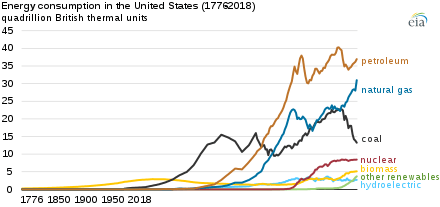
The Obama administration made a large push for green jobs, particularly in his first term.[74]
In the United States, the share of renewable energy (excluding hydropower) in electricity generation has grown from 3.3 percent (1990) to 5.5 percent (2013).[75] Oil use will decline in the USA owing to the increasing efficiency of the vehicle fleet and replacement of crude oil by natural gas as a feedstock for the petrochemical sector. One forecast is that the rapid uptake of electric vehicles will reduce oil demand drastically, to the point where it is 80% lower in 2050 compared with today.[76]
In December 2016, Block Island Wind Farm became the first commercial US offshore wind farm. It consists of five 6 MW turbines (together 30 MW) located near-shore (3.8 miles (6.1 km) from Block Island, Rhode Island) in the Atlantic Ocean. At the same time, Norway-based oil major Statoil laid down nearly $42.5 million on a bid to lease a large offshore area off the coast of New York.[77]
Federal Legislation
1. The Energy Policy Act of 2005
This act was enacted by the 109th U.S. Congress and signed into legislation by President George W. Bush on 8 August 2005. It addresses multiple facets of energy production in the United States, including renewable energy, energy efficiency, tax incentives, climate change technology, and several more topics surrounding the use of fossil fuels[78]. This act and its contents can be found here.
2. The Energy Independence and Security Act of 2007
This act was enacted by the 110th U.S. Congress and went into effect 19 December 2007. The primary goals of this act are to:
- move the United States toward greater energy independence and security;
- increase the production of clean renewable fuels;
- protect consumers;
- increase the efficiency of products, buildings, and vehicles;
- promote research on and deploy greenhouse gas capture and storage options;
- improve the energy performance of the Federal Government; and
- increase U.S. energy security, develop renewable fuel production, and improve vehicle fuel economy[79].
Three key provisions are also included: the Corporate Average Fuel Economy Standards, the Renewable Fuel Standard, and the appliance/lighting efficiency standards[80]. This act and its contents can be found here.
3. Executive Order 13423
This executive order, "Strengthening Federal Environmental, Energy, and Transportation Management," was signed by President George W. Bush on 24 January 2007. This order instructs Federal agencies to "conduct their environmental, transportation, and energy-related activities under the law in support of their respective missions in an environmentally, economically and fiscally sound, integrated, continuously improving, efficient, and sustainable manner,"[81]. The order sets goals in these areas:
- energy efficiency
- acquisition
- renewable energy
- toxic chemical reduction
- recycling
- sustainable buildings
- electronics stewardship
- fleets
- water conservation
This order and its contents can be found here.
4. Executive Order 13514
This executive order, "Federal Leadership in Environmental, Energy, and Economic Performance," was signed by President Barack Obama on 5 October 2009. This order builds off of Executive Order 13423 and expands on the energy reduction and environmental performance requirements for Federal agencies that were identified in this previous order. Its goal is stated as follows: "to establish an integrated strategy towards sustainability in the Federal Government and to make reduction of greenhouse gas emissions a priority for Federal agencies." This order set forth several deadlines for Federal agencies to meet in order to achieve the greenhouse gas reduction goals outlined[82].
This executive order was revoked by Executive Order 13693, signed into office by President Barack Obama on 19 March 2015. This order set new goals to be met by Federal agencies in regard to greenhouse gas emission reduction, along with other environmental conservation efforts[83]. However, this executive order was revoked by Executive Order 13834, signed by President Trump on 17 May 2018[84].
5. Presidential Memorandum: Federal Leadership on Energy Management
This Presidential Memorandum was issued by President Barack Obama on 5 December 2013. This directive established new goals for renewable energy as well as new energy management practices. The Memorandum set a new renewable energy use target, with the goal of 20% of electric energy consumed by Federal agencies to be derived from renewable sources. It also addresses building performance and energy management, and touches on a few other topics related to renewable energy[85].
6. The President's Climate Action Plan of 2013
This plan was first created in 2007 by President Barack Obama and was updated every two years afterwards until 2013. This plan began with an outline on "Cutting Carbon Pollution in America." This section describes plans to cut emissions from power plants and how to promote leadership in renewable energy, along with several other topics related to decreasing carbon dioxide emissions across several sectors. There are two other sections (Prepare the United States for the Impacts of Climate Change, Lead International Efforts to Address Global Climate Change) that, while integral to the conversation regarding climate change, do not directly address renewable energy[86].
See also
- 100% renewable energy
- Amory Lovins
- Cost of electricity by source#United States
- Solar power in the United States
- Energy Observer
- Energy transition in Germany
- The Fourth Revolution: Energy
- Fossil-fuel phase-out
- Germany National Renewable Energy Action Plan
- Green industrial policy
- Green New Deal
- List of countries by renewable electricity production
- One Earth Climate Model
- Paris Agreement
- Passivhaus
- Renewable energy commercialization
- Renewable energy in the European Union
- Soft energy path
References
- "World Energy Council. 2014. Global Energy Transitions".
- Smil, Vaclav. 2010. Energy Transitions. History, Requirements, Prospects. Praeger
- Notter, Dominic A. (2015-01-01). "Small country, big challenge: Switzerland's upcoming transition to sustainable energy". Bulletin of the Atomic Scientists. 71 (4): 51–63. Bibcode:2015BuAtS..71d..51N. doi:10.1177/0096340215590792. ISSN 0096-3402.
- Federal Ministry for the Environment (29 March 2012). Langfristszenarien und Strategien für den Ausbau der erneuerbaren Energien in Deutschland bei Berücksichtigung der Entwicklung in Europa und global [Long-term Scenarios and Strategies for the Development of Renewable Energy in Germany Considering Development in Europe and Globally] (PDF). Berlin, Germany: Federal Ministry for the Environment (BMU). Archived from the original (PDF) on 27 October 2012.
- https://www.bmwi.de/BMWi/Redaktion/PDF/V/vierter-monitoring-bericht-energie-der-zukunft-englische-kurzfassung,property=pdf,bereich=bmwi2012,sprache=de,rwb=true.pdf Archived 20 September 2016 at the Wayback Machine pg6
- "Das steht im Abschlusstext von Union und SPD". Sueddeutsche.de. 2018-09-04.
- Grübler, A. (1991). "Diffusion: Long-term patterns and discontinuities". Technological Forecasting and Social Change. 39 (1–2): 159–180. doi:10.1016/0040-1625(91)90034-D.
- Grübler, A; Wilson, C.; Nemet, G. (2016). "Apples, oranges, and consistent comparisons of the temporal dynamics of energy transitions" (PDF). Energy Research & Social Science. 22 (12): 18–25. doi:10.1016/j.erss.2016.08.015.
- Louis Boisgibault, Fahad Al Kabbani (2020): Energy Transition in Metropolises, Rural Areas and Deserts. Wiley - ISTE. (Energy series) ISBN 9781786304995.
- Henrik Paulitz: Dezentrale Energiegewinnung - Eine Revolutionierung der gesellschaftlichen Verhältnisse. IPPNW. (Decentralized Energy Production - Revolutionizing Social Relations) Accessed 20 January 2012.
- Häfelse, W; Sassin, W (1977). "The global energy system". Annual Review of Energy. 2: 1–30. doi:10.1146/annurev.eg.02.110177.000245.
- Höök, Mikael; Li, Junchen; Johansson, Kersti; Snowden, Simon (2011). "Growth Rates of Global Energy Systems and Future Outlooks". Natural Resources Research. 21 (1): 23–41. doi:10.1007/s11053-011-9162-0.
- Sovacool, Benjamin K. (2016-03-01). "How long will it take? Conceptualizing the temporal dynamics of energy transitions". Energy Research & Social Science. 13: 202–215. doi:10.1016/j.erss.2015.12.020. ISSN 2214-6296.
- Podobnik, B. (1999). "Toward a sustainable energy regime: a long-wave interpretation of global energy shifts". Technological Forecasting and Social Change. 62 (3): 155–172. doi:10.1016/S0040-1625(99)00042-6.
- Rühl, C.; Appleby, P.; Fennema, F.; Naumov, A.; Schaffer, M. (2012). "Economic development and the demand for energy: a historical perspective on the next 20 years". Energy Policy. 50: 109–116. doi:10.1016/j.enpol.2012.07.039.
- Debeir, J.C.; Deléage, J.P.; Hémery, D. (1991). In the Servitude of Power: Energy and Civilisation Through the Ages. London: Zed Books. ISBN 9780862329426.
- Nef, J.U (1977). "Early energy crisis and its consequences". Scientific American. 237 (5): 140–151. Bibcode:1977SciAm.237e.140N. doi:10.1038/scientificamerican1177-140.
- Fouquet, R.; Pearson, P.J.G. (1998). "A thousand years of energy use in the United Kingdom". The Energy Journal. 19 (4): 1–41. doi:10.5547/issn0195-6574-ej-vol19-no4-1. JSTOR 41322802.
- Unger, R.W. (1984). "Energy sources for the dutch golden age: peat, wind, and coal". Research in Economic History. 9: 221–256.
- Bardi, U. (2007). "Energy prices and resource depletion: lessons from the case of whaling in the nineteenth century" (PDF). Energy Sources, Part B: Economics, Planning, and Policy. 2 (3): 297–304. doi:10.1080/15567240600629435.
- Armaroli, Nicola; Balzani, Vincenzo (2007). "The Future of Energy Supply: Challenges and Opportunities". Angewandte Chemie. 46 (1–2): 52–66 [52]. doi:10.1002/anie.200602373. PMID 17103469.
- Christiana Figueres, Hans Joachim Schellnhuber, Gail Whiteman, Johan Rockström, Anthony Hobley, Stefan Rahmstorf (2017): Three years to safeguard our climate. Nature [DOI: 10.1038/546593a]
- Grübler, A.; Nakićenović, N.; Victor, D.G. (1999). "Dynamics of energy technologies and global change" (PDF). Energy Policy. 27 (5): 247–280. doi:10.1016/S0301-4215(98)00067-6.
- Hirsch, R.F.; Jones, C.F. (2014). "History's contributions to energy research and policy". Energy Research & Social Science. 1 (3): 106–111. doi:10.1016/j.erss.2014.02.010.
- Sovacool, Benjamin K (2016). "How long will it take? Conceptualizing the temporal dynamics of energy transitions". Energy Research and Social Science. 13: 202–215. doi:10.1016/j.erss.2015.12.020.
- Strunz, Sebastian (2014). "The German energy transition as a regime shift". Ecological Economics. 100: 150–158. doi:10.1016/j.ecolecon.2014.01.019. hdl:10419/76875.
- CIFAR. "The Future of Basic and Applied Energy Research". CIFAR.
- CIFAR. "The Sustainability of Global Energy Consumption Demand and Supply Needs". CIFAR.
- CIFAR. "The Role of Regulation in Inducing Clean Energy Adoption". CIFAR.
- Pai, Sandeep; Carr-Wilson, Savannah (2018). Total Transition: The Human Side of the Renewable Energy Revolution. Rocky Mountain Books. ISBN 978-1-77160-248-8.
- "Climate Frontlines Briefing - No Jobs on a Dead Planet" (PDF). International Trade Union Confederation. March 2015. Retrieved 2020-03-27.
- Smith, Samantha (May 2017). "Just Transition" (PDF). Just Transition Centre.
- Brecher, Jeremy (2019). "Making the Green New Deal Work for Workers". In These Times. Retrieved 2019-05-02.
- "Resolution concerning sustainable development, decent work and green jobs" (PDF). International Labour Organization. 2013-06-13. Retrieved 2020-03-26.
- "Guidelines for a just transition towards environmentally sustainable economies and societies for all". International Labour Organization. 2020-02-02. ISBN 978-92-2-130628-3. Retrieved 2020-03-26.
- "Adoption of the Paris Agreement. Proposal by the President". United Nations Framework Convention on Climate Chang. 2015-12-12. p. 21. Retrieved 2020-03-03.
- "DNV GL's Energy Transition Outlook 2018". eto.dnvgl.com. Retrieved 2018-10-16.
- Ben Sills (2011-08-29). "Solar May Produce Most of World's Power by 2060, IEA Says". Bloomberg.
- Overland, Indra; Bazilian, Morgan; Ilimbek Uulu, Talgat; Vakulchuk, Roman; Westphal, Kirsten (2019). "The GeGaLo index: Geopolitical gains and losses after energy transition". Energy Strategy Reviews. 26: 100406. doi:10.1016/j.esr.2019.100406.
- "Key world energy statistics" (PDF). IEA. 2015. Retrieved 2017-04-06.
- BP: Statistical Review of World Energy, Workbook (xlsx), London, 2016
- World Energy Assessment (WEA). UNDP, United Nations Department of Economic and Social Affairs, World Energy Council, New York
- "Statistical Review of World Energy (June 2018)" (PDF). Retrieved 2019-09-27.
- "An Australian model for the renewable-energy transition". www.lowyinstitute.org. Retrieved 2019-07-08.
- "Fostering Effective Energy Transition 2019". Fostering Effective Energy Transition 2019. Retrieved 2019-07-08.
- Modell Güssing - Wussten Sie, dass ... Archived 8 March 2014 at the Wayback Machine.
- Sonne: Im Norden ging die auf. In Tagesspiegel, 18 October 2010. Retrieved 19 October 2012.
- Nuclear Energy in Denmark. http://www.world-nuclear.org. Retrieved 19 October 2012.
- Erich Hau, Windkraftanlagen: Grundlagen, Technik, Einsatz, Wirtschaftlichkeit, Berlin - Heidelberg 2008, p45.
- Die Kraft aus der Luft. In: Die Zeit, 6 February 2012. Retrieved 19 October 2012.
- Erich Hau, Windkraftanlagen: Grundlagen, Technik, Einsatz, Wirtschaftlichkeit, Berlin - Heidelberg 2008, p56.
- Renewables now cover more than 40% of electricity consumption Archived 3 March 2016 at the Wayback Machine. Danish Energy Agency. Retrieved 19 October 2012.
- Dänemark hat neue Regierung In: Neues Deutschland, 4 October 2011. Retrieved 19 October 2012.
- DK Energy Agreement Archived 19 May 2016 at the Portuguese Web Archive. March 22, 2012.
- Abschied vom Ölkessel. In: heise.de, 16 February 2013. accessed on 16 February 2013.
- La transition énergétique, un vrai vecteur de croissance pour la France Les échos, Mai 2012
- Transition énergétique: quels moyens et quels coûts? batiactu 21. September 2012
- Conférence environnementale des 14-15 septembre 2012 developpement-durable.gouv.fr, September 2012
- "Archived copy" (PDF). Archived from the original (PDF) on 2013-07-17. Retrieved 2013-07-14.CS1 maint: archived copy as title (link)
- AVEM, Association. "Adoption de la loi sur la transition énergétique".
- http://www.iea.org/publications/freepublications/publication/KeyWorld2014.pdf pg51
- Girl, Energy. "Strommix 2017 Deutschland: Stromerzeugung nach Energiequellen". Stromvergleich.
- "Germany's energy transformation Energiewende". The Economist. 2012-07-28. Retrieved 2013-03-06.
- "Germany's energy reform: Troubled turn". The Economist. 2013-02-09. Retrieved 2013-03-06.
- The Energy of the Future: Fourth "Energy Transition" Monitoring Report — Summary (PDF). Berlin, Germany: Federal Ministry for Economic Affairs and Energy (BMWi). November 2015. Archived from the original (PDF) on 20 September 2016. Retrieved 9 June 2016.
- Wegen Reaktorunglück in Fukushima: Japan verkündet Atomausstieg bis 2040 at focus.de, 14 September 2012 (accessed on 14 September 2012).
- Energiewende: Japan schränkt Atomausstieg wieder ein at zeit.de, 19 September 2012 (accessed on 20 September 2012).
- "Remarks by President Moon Jae-in at a Ceremony Marking the Permanent Closure of the Kori No.1 Nuclear Reactor". english1.president.go.kr. Retrieved 2020-08-05.
- "에너지전환- 에너지정보소통센터". www.etrans.or.kr (in Korean). Retrieved 2020-08-05.
- "FAQ - 에너지정보소통센터". www.etrans.or.kr (in Korean). Retrieved 2020-08-05.
- "제3차 에너지기본계획 최종 확정". www.korea.kr (in Korean). Retrieved 2020-08-05.
- "Third Energy Master Plan" (PDF). etrans. 2019.
- "[정책위키] 한눈에 보는 정책 - 에너지전환 정책". www.korea.kr (in Korean). Retrieved 2020-08-05.
- Christopher F. Jones (March 2016): Energy Transitions in the United States - Worker opportunities past, present, and future. (PDF (3 MB)
- Alexander Ochs, Christoph von Friedeburg (2014) / www.worldwatch.org: Energy Transitions in Germany and the United States. Transatlantic Perspectives, Challenges, and the Way Forward, p. 3. Figure 1 is based on (footnote 8 of the paper names the sources) http://data.worldbank.org, www.eia.gov (2016 edition of the report here (pdf, 13 MB) and an EUROSTAT website.
- "DNV GL's Energy Transition Outlook 2018". eto.dnvgl.com. Retrieved 2018-10-17.
- It was “the highest bid ever for a U.S. offshore wind energy area,” according to the American Wind Energy Association. The leased area has the potential to develop more than 1 gigawatt of offshore wind, which is a sizeable offshore wind park. (source: washingtonpost.com 19 December 2016)
- "FERC: Energy Policy Act (EPAct) of 200". www.ferc.gov. Retrieved 2020-03-30.
- US EPA, OA (2013-02-22). "Summary of the Energy Independence and Security Act". US EPA. Retrieved 2020-03-30.
- "H.R.6 - 110th Congress (2007-2008): Energy Independence and Security Act of 2007". www.congress.gov. 2007-12-19. Retrieved 2020-03-30.
- "FedCenter - EO 13423 (Archive) - revoked by EO 13693 on March 19, 2015, Sec. 16(a)". www.fedcenter.gov. Retrieved 2020-03-30.
- "FedCenter - EO 13514 (Archive) - revoked by EO 13693 on March 19, 2015, Sec. 16(b)". www.fedcenter.gov. Retrieved 2020-03-30.
- "FedCenter - EO 13693 (Archive) - revoked by EO 13834 on May 17, 2018, Sec. 8". www.fedcenter.gov. Retrieved 2020-03-30.
- "Efficient Federal Operations". Federal Register. 2018-05-22. Retrieved 2020-03-30.
- "Presidential Memorandum -- Federal Leadership on Energy Management". whitehouse.gov. 2013-12-05. Retrieved 2020-03-30.
- President Barack Obama (2013). "The President's Climate Action Plan." Executive Office of the President. https://obamawhitehouse.archives.gov/sites/default/files/image/president27sclimateactionplan.pdf
Further reading
- Clean Tech Nation: How the U.S. Can Lead in the New Global Economy (2012) by Ron Pernick and Clint Wilder
- Deploying Renewables 2011 (2011) by the International Energy Agency
- Armstrong, Robert C., Catherine Wolfram, Robert Gross, Nathan S. Lewis, and M.V. Ramana et al. The Frontiers of Energy, Nature Energy, Vol 1, 11 January 2016.
- Reinventing Fire: Bold Business Solutions for the New Energy Era (2011) by Amory Lovins
- Renewable Energy Sources and Climate Change Mitigation (2011) by the IPCC
- Solar Energy Perspectives (2011) by the International Energy Agency
External links
| Wikimedia Commons has media related to Energy transition. |
- energytransition: about (German and world-wide) Energytransition (and Wiki about German Energiewende)
- Visual Capitalist, October 31st, 2018, Iman Gosh, visualcapitalist.com: Visualizing the Global Transition to Green Energy